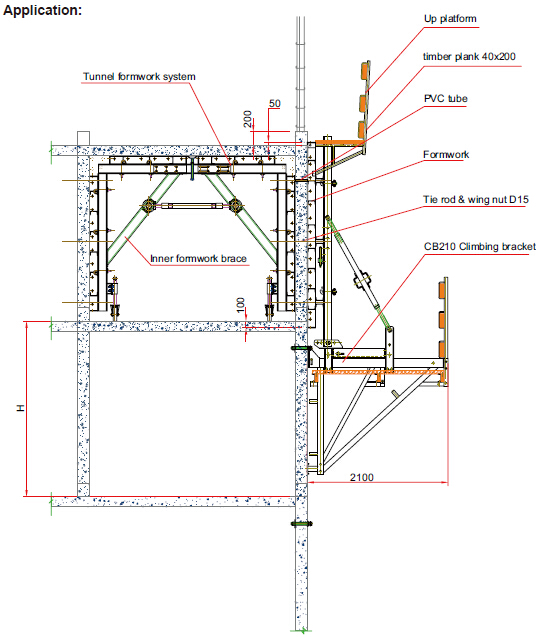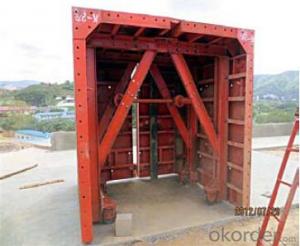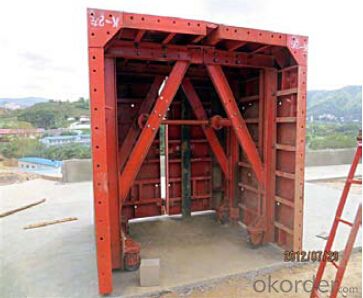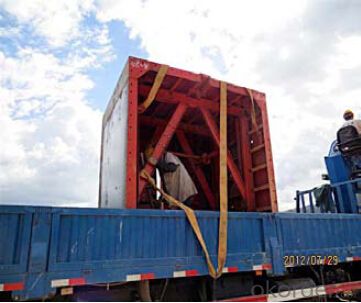Steel Tunnel for Formwork and Scaffolding system
- Loading Port:
- Tianjin
- Payment Terms:
- TT OR LC
- Min Order Qty:
- 50 m²
- Supply Capability:
- 1000 m²/month
OKorder Service Pledge
Quality Product, Order Online Tracking, Timely Delivery
OKorder Financial Service
Credit Rating, Credit Services, Credit Purchasing
You Might Also Like
Building Tunnel Formwork:
A compositional steel formwork system mainly used in the building which has regular structure
without beams, the excellent formwork system can make the integral pouring for the wall & slab
easily achieved.
Characteristics:
◆ High stiffness, make perfect shape for concrete.
◆ Easy operation, save labor and force.
◆ Fast forming, repeatedly turnover.

- Q: Is steel formwork more expensive than other types of formwork?
- The cost of steel formwork depends on various factors such as the size and complexity of the project, availability of materials, labor costs, and market conditions. Generally speaking, steel formwork tends to be more expensive than other types of formwork such as wood or aluminum. Steel formwork offers several advantages over other types of formwork, such as high durability, reusability, and the ability to support heavy loads. However, these benefits come at a higher price. Steel formwork requires a higher initial investment due to the cost of materials and the need for skilled labor for fabrication and installation. On the other hand, wood or aluminum formwork may be less expensive initially, but they may not be as durable or have the same load-bearing capacity as steel formwork. They might require frequent repairs or replacements, which can add to the overall cost in the long run. Ultimately, the choice of formwork material depends on the specific requirements of the project, budget constraints, and the expected number of uses. While steel formwork may be more expensive upfront, it often provides a better return on investment due to its durability and reusability.
- Q: Can steel formwork be used for railway construction projects?
- Yes, steel formwork can be used for railway construction projects. Steel formwork is known for its strength, durability, and versatility, making it suitable for various construction applications, including railway projects. It can provide a sturdy and reliable support system for concrete casting, ensuring the construction of durable and long-lasting railway structures.
- Q: What are the maintenance requirements for steel formwork?
- The maintenance requirements for steel formwork typically involve regular cleaning to remove any debris or concrete buildup, inspection for signs of wear or damage, and occasional repairs or replacement of damaged components. Additionally, applying a protective coating or rust inhibitor can help prevent corrosion and prolong the lifespan of the formwork.
- Q: Can steel formwork be used in hotel or hospitality construction projects?
- Yes, steel formwork can be used in hotel or hospitality construction projects. Steel formwork offers several advantages such as durability, reusability, and high load-bearing capacity, making it suitable for constructing structures like hotels that require long-term strength and stability. Additionally, steel formwork allows for efficient construction processes and can help in achieving desired architectural designs.
- Q: Is steel formwork suitable for projects with limited access?
- Yes, steel formwork is suitable for projects with limited access. Steel formwork is known for its strength and durability, allowing it to be easily transported and assembled in confined spaces. Additionally, steel formwork can be customized to fit specific project requirements, making it an ideal choice for projects with limited access.
- Q: Are there any specific design considerations for steel formwork?
- Yes, there are several specific design considerations for steel formwork. Firstly, the design should take into account the load-bearing capacity of the steel formwork. Steel has high strength and rigidity, but it is important to ensure that the formwork is designed to withstand the loads imposed by the concrete during pouring and curing. Secondly, the design should consider the dimensional accuracy required for the concrete structure. Steel formwork should be designed to provide precise dimensions and smooth finishes to ensure the desired shape and appearance of the final concrete structure. Thirdly, the design should incorporate proper connection details for assembling and dismantling the steel formwork. It is important to ensure that the formwork can be easily assembled and disassembled, as this can significantly impact the construction timeline and efficiency. Additionally, the design should consider the ease of handling and transportation of the steel formwork. Steel formwork components should be designed to be lightweight and easily maneuverable, making it easier for construction workers to handle and transport them on site. Furthermore, the design should take into account the durability and longevity of the steel formwork. Steel is known for its high durability and resistance to corrosion, but proper protective coatings or treatments should be specified to ensure the longevity of the formwork and prevent any degradation over time. Lastly, the design should consider any specific requirements or constraints of the project, such as special architectural features, complex geometries, or unique structural elements. These considerations may require custom design solutions to meet the specific needs of the project. Overall, the design considerations for steel formwork involve load-bearing capacity, dimensional accuracy, connection details, ease of handling and transportation, durability, and any project-specific requirements.
- Q: How does steel formwork contribute to the overall sustainability of the project?
- There are several ways in which steel formwork contributes to the overall sustainability of a project. Firstly, steel is an incredibly durable material that can withstand heavy loads and repeated use. This means that the same steel formwork can be used for multiple construction cycles, reducing the need for new formwork materials and minimizing waste. Moreover, steel formwork is highly adaptable and can easily be customized to meet various design requirements. This flexibility allows for efficient material usage and reduces the amount of construction waste generated. Furthermore, steel formwork is highly recyclable. When it reaches the end of its life cycle, it can be easily taken apart and recycled. This reduces the demand for new steel production and minimizes the environmental impact associated with mining and manufacturing new materials. Additionally, compared to traditional timber formwork, steel formwork offers better quality control. It provides precise and consistent dimensions, resulting in a final product of high accuracy and quality. This reduces the need for rework and ensures less material wastage. Lastly, the use of steel formwork can lead to shorter construction periods. Its quick assembly and disassembly allow for faster construction processes, reducing the overall energy consumption and carbon emissions associated with the project. To conclude, steel formwork contributes to the overall sustainability of a project through its durability, recyclability, versatility, and efficiency. By reducing waste, minimizing environmental impact, and improving construction processes, steel formwork helps create more sustainable and environmentally-friendly construction projects.
- Q: How does steel formwork handle different concrete finishing techniques?
- Steel formwork offers a wide range of possibilities for concrete finishing techniques due to its high versatility. It possesses great strength and durability, enabling it to withstand the pressure and forces exerted throughout various finishing procedures. When aiming for a smooth finish, steel formwork provides a solid and stable surface that facilitates easy pouring and leveling of the concrete. Its rigidity guarantees that the concrete remains in position and does not sag or deform during the finishing process. Consequently, the concrete can be smoothly troweled, resulting in a polished and uniform surface. Steel formwork is also suitable for textured finishes. It can be customized with different patterns and textures to create unique and decorative concrete surfaces. By utilizing specially designed steel formwork, such as those with corrugated or embossed patterns, the concrete can be poured to replicate these designs, resulting in visually appealing textured finishes. Furthermore, steel formwork is capable of accommodating exposed aggregate finishes. This technique involves removing the top layer of concrete to reveal the underlying aggregate stones, thus creating a decorative effect. Steel formwork can be designed with removable panels or inserts that allow the concrete to be poured in a way that exposes the desired amount of aggregate. After the concrete has cured, these removable panels can be easily taken off, revealing the desired exposed aggregate finish. Moreover, steel formwork is suitable for stamped concrete finishes. Stamped concrete involves imprinting patterns or textures onto the concrete surface using specialized stamps. Steel formwork provides a solid foundation for these stamps to be pressed onto, ensuring accurate and consistent imprints. The rigidity of steel formwork prevents the concrete from shifting or deforming during the stamping process, resulting in precise and high-quality stamped finishes. Overall, steel formwork is highly compatible with various concrete finishing techniques. Its strength, stability, and versatility make it an ideal choice for handling different finishing processes, allowing for the creation of smooth, textured, exposed aggregate, and stamped concrete finishes with precision and ease.
- Q: What are the different types of formwork anchors used in steel formwork?
- There are several types of formwork anchors that are commonly used in steel formwork. These anchors are essential for securing the formwork to the structure and ensuring the stability and safety of the construction process. Some of the different types of formwork anchors used in steel formwork include: 1. Wedge Anchor: This type of anchor consists of a threaded rod with a wedge-shaped end. It is inserted into a pre-drilled hole in the concrete structure and secured by tightening a nut on the threaded end. The wedge anchor provides a strong grip and is commonly used for securing formwork to concrete walls or slabs. 2. Screw Anchor: Screw anchors, also known as self-tapping anchors, are designed for use in softer materials such as wood or light-gauge steel. They have a threaded body that is screwed into the material, providing a secure connection for the formwork. Screw anchors are easy to install and remove, making them a popular choice for temporary formwork applications. 3. Hook Anchor: This type of anchor is shaped like a hook and is typically embedded into the concrete structure during the pouring process. The formwork is then attached to the hook using bolts or other fasteners. Hook anchors provide a strong and reliable connection and are commonly used in applications where high loads or lateral forces are expected. 4. Swift Lift Anchor: Swift lift anchors are specifically designed for lifting and handling precast concrete elements, including steel formwork. These anchors are embedded into the structure during the pouring process and provide a safe and efficient method for lifting and positioning the formwork. 5. Plate Anchor: Plate anchors consist of a flat plate with holes for bolts or other fasteners. They are commonly used in steel formwork systems to secure the formwork to the structure. Plate anchors are versatile and can be easily adjusted or relocated as needed. 6. Chemical Anchor: Chemical anchors are used when a strong and permanent connection is required. These anchors consist of a resin or adhesive that is injected into a pre-drilled hole in the concrete structure. The steel formwork is then attached to the chemical anchor, creating a secure bond. Each type of formwork anchor has its own unique advantages and is suitable for different applications. The choice of anchor will depend on factors such as the type of structure, the load requirements, and the duration of use. It is important to select the appropriate anchor and ensure proper installation to ensure the safety and stability of the formwork system.
- Q: How does steel formwork affect the overall construction site aesthetics?
- Steel formwork can greatly enhance the overall aesthetics of a construction site. Its sleek and modern appearance gives a professional look to the project, creating a sense of organization and efficiency. Steel formwork's clean lines and smooth finishes provide a visually pleasing backdrop for the construction process, improving the overall visual appeal of the site. Additionally, its durability and ability to create precise and intricate designs contribute to a more refined and sophisticated aesthetic outcome.
Send your message to us
Steel Tunnel for Formwork and Scaffolding system
- Loading Port:
- Tianjin
- Payment Terms:
- TT OR LC
- Min Order Qty:
- 50 m²
- Supply Capability:
- 1000 m²/month
OKorder Service Pledge
Quality Product, Order Online Tracking, Timely Delivery
OKorder Financial Service
Credit Rating, Credit Services, Credit Purchasing
Similar products
Hot products
Hot Searches
Related keywords



















